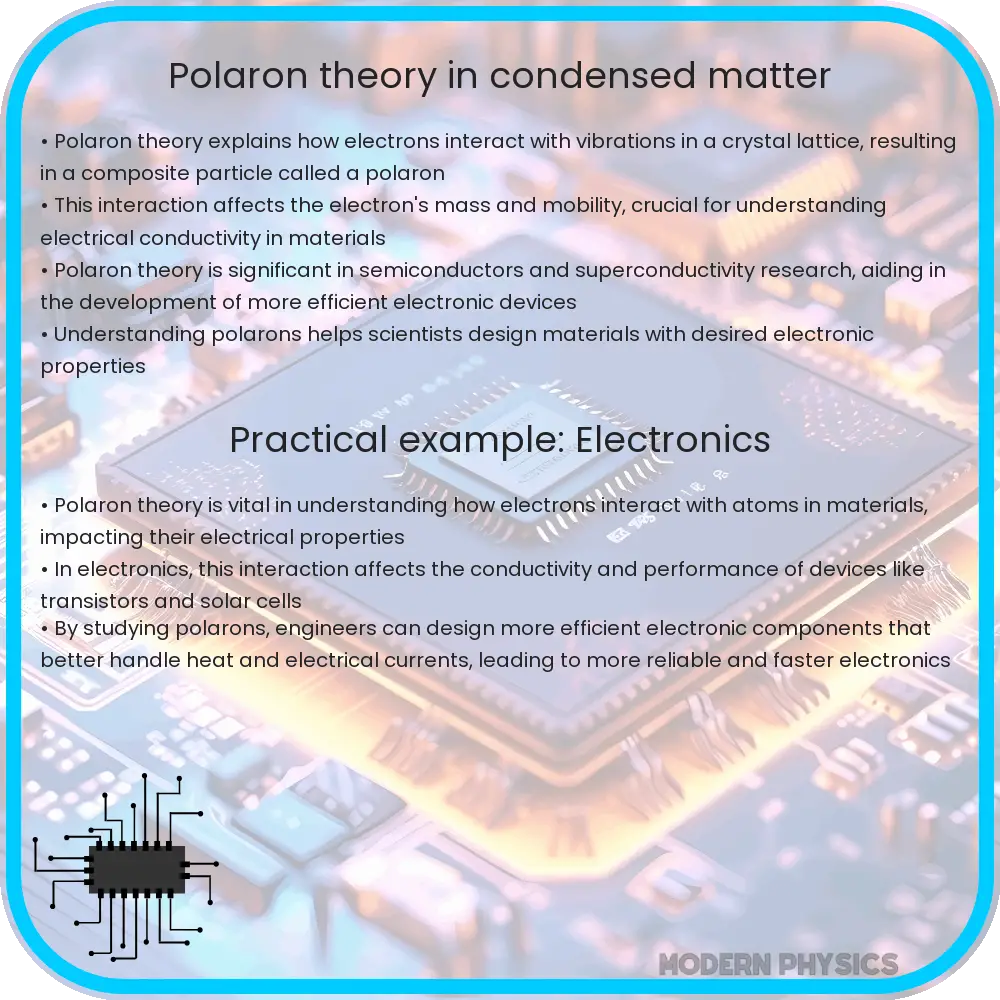Polaron theory is a pivotal concept in condensed matter physics, contributing significantly to our understanding of complex materials and their behaviors. A polaron can be conceptualized as a quasi-particle emerging from the interaction between an electron and the phononic lattice of a crystalline material. This interaction plays a crucial role not only in the fundamental understanding of electron dynamics but also in the development of novel electronic and optoelectronic devices. This article delineates the essential characteristics of polarons, their types, formation mechanisms, and implications in various research domains.
1. Definition of a Polaron
A polaron is defined as an electron (or hole) which is coupled with the lattice deformation it creates within a solid-state system. When an electron traverses a lattice, it disturbs the surrounding atoms, which leads to a localized distortion of the lattice structure. This coupled state effectively results in the creation of a new, mobile entity known as a polaron. The strength of the coupling between the electron and the phonons, or lattice vibrations, dictates the polaron’s characteristics and behavior.
2. Types of Polarons
Polarons can be primarily classified into two distinct categories: small polarons and large polarons. The distinction between these two types is fundamentally rooted in the degree of coupling with the lattice phonons and the effective mass they embody.
2.1 Small Polarons
Small polarons arise in materials where the electron-phonon coupling is strong. In this scenario, the lattice distortion is localized tightly around the electron, leading to a significant increase in the effective mass of the carrier. Small polarons typically exhibit activated transport properties, meaning their mobility is highly temperature-dependent and becomes more pronounced at higher temperatures. A classic example of small polarons can be found in transition metal oxides, where ionic lattices facilitate strong coupling.
2.2 Large Polarons
Conversely, large polarons are characterized by weak electron-phonon coupling. In this case, the lattice distortion is spread across a larger region, resulting in a lower effective mass and enhanced mobility compared to small polarons. The formation of large polarons often dictates behavior seen in organic semiconductors and certain molecular crystals. These polarons tend to exhibit a more delocalized nature, allowing for coherent quantum transport over greater distances.
3. Mechanisms of Polaron Formation
The formation of polarons is fundamentally governed by the electron-phonon interaction, which can be classified into two main types: dynamic and static coupling. Each mechanism elucidates the different pathways by which polarons arise in various materials.
3.1 Dynamic Coupling
Dynamic coupling occurs in materials where the lattice responds in a time-dependent manner to the presence of an electron. This interaction facilitates the generation of phonons as the electron moves through the lattice. As these phonons scatter, they provide an effective means of transporting the electron, leading to the polaronic state. This mechanism is particularly significant in high-temperature superconductors where electron-phonon coupling plays a pivotal role in superconductivity.
3.2 Static Coupling
Static coupling, on the other hand, pertains to scenarios where the lattice distortion generated by the electron remains largely anchored in space, independent of the electron’s instantaneous position. This can occur in strongly correlative systems or in heavily doped semiconductors. Static coupling complicates the electronic landscape by introducing localized states that can trap charge carriers and significantly affect conductivity properties.
4. Polarons in Diverse Materials
The significance of polarons transcends their fundamental definition, extending into various material classes and applications. Understanding polarons is crucial for the advancement of several technologies, particularly in the field of electronics.
4.1 Semiconductors
In semiconductor materials, polarons can influence carrier conduction significantly. For instance, in doped semiconductors, the presence of polarons can lead to increased resistivity due to localized states that impede carrier mobility. This aspect is vital in the fabrication of high-performance devices such as transistors and solar cells, where optimized electronic properties are paramount.
4.2 Superconductors
Polarons play a critical role in elucidating the mechanism behind high-temperature superconductivity. The interaction between electrons and phonons may be responsible for pairing mechanisms that facilitate the superconducting state. Understanding polarons can, therefore, unlock avenues for enhancing superconducting transition temperatures and elucidating the underlying physics of these fascinating materials.
4.3 Organic Conductors
In organic conductors, polarons significantly affect their electrical properties and conductivity. The existence of polarons can lead to fascinating phenomena, such as charge ordering and the emergence of novel degrees of freedom in organic materials. This compels researchers to investigate how polarons can be harnessed in organic photovoltaic cells and flexible electronics.
5. Conclusion
In summary, the concept of polarons in condensed matter physics encompasses a rich tapestry of interactions between electrons and lattice vibrations. The characterization of polarons as small or large, along with a profound understanding of their formation mechanisms, is vital for unraveling their implications in real-world materials. This knowledge serves as a bedrock for innovations in electronic devices, superconductivity, and the burgeoning field of organic conductors. As research progresses, continuous exploration of polarons will undoubtedly lead to transformative advances in material science and condensed matter physics.












